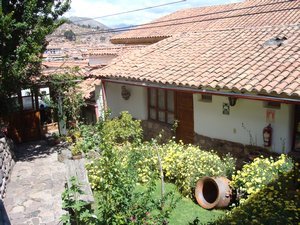Advertisement
Published: December 2nd 2009

 Home Sweet Home
Home Sweet Home
A view from our room of the hotel courtyard. Cusco can be seen in the distance.The title is a little bit misleading. Obviously this trip was over a week, not all in one day. Especially with our navigational skills. I digress...After our visit to Lima, we took a flight to Cusco. The town of Cusco was declared a UNESCO World Heritage Site in 1983 and was historically the political capitol of the Inca Empire and was pronounced something closer to "Cosco" before the Spainish changed the name to a more appropriately Iberic: "Cusco". The city was planned by Pachacutec, the ninth Inca leader ,and was built to resemble a puma, which was sacred, lying on its side. It was very well planned, not only for security purposes, but also for having a source of fresh water, the Urubamba River, which eventually runs into Lake Titicaca.
Cusco is located about 11,000 feet above sea level. The oxygen is much thinner at this altitude. I didn't think much of it until I had to go uphill and was struggling like an octogenarian smoker with asthma (which I am not). The city had a certain atmosphere in the center, all old stones and narrow paths. Its charm, however, was mitigated by the thich stink of automobile pollution. There

 La Catedral
La Catedral
A view of the corner of the Cathedral, which was started in 1560. It was built on top of the palace of Vircocha, the eight Inca, to symbolize the defeat of the Inca empire. In addition, granite slabs brought from the fortress of Sacsayhuaman were used for the construction of the first chapel to further demonstarate Spanish dominance.was traffic and cars everwhere (hello, UNESCO, maybe we should cut down on traffic?) and the lack of oxygen made the problem feel so much worse. Oh, and the large amounts of tourists in the off season. The rainy season had well begun by the time we reached the highlands.
I think at that point, we began to wonder if the whole venture up here was not some kind of tourist trap. We stayed at a very lovely, rustic hotel (located in the middle of a very steep hill). We arrived in Cusco with train tickets the next day to Machu Picchu and not much else. Luckily, an enterprising and ultimately lovable local, whom we nicknamed Big Al, ambushed us as soon as we got in and before you know it, everthing was planned out for the next day. We would take the train from Poroy station to Aguas Calientes, take the bus up to Machu Picchu, where a guide would be waiting for us to show us the sights.
As we sat on the train to Aguas Calientes, we had some serious doubts about what awaited us in Machu Picchu. Alas, you will have to wait until

 La Catedral 2
La Catedral 2
A view of the Cathedral from the Plaza de Armas.the next installation to find out how we fared. Stay tuned!
Advertisement
Tot: 0.064s; Tpl: 0.013s; cc: 7; qc: 54; dbt: 0.0361s; 1; m:domysql w:travelblog (10.17.0.13); sld: 1;
; mem: 1.1mb

 Home Sweet Home
Home Sweet Home
 La Catedral
La Catedral
 La Catedral 2
La Catedral 2
























